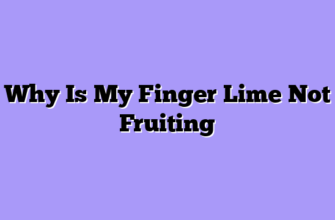When I first heard about Australian Finger Lime – or as we locals sometimes call it, “bush caviar” – I thought it was just another exotic fruit fad. Boy, was I wrong! This remarkable citrus, scientifically known as Citrus australasica, has become one of my most profitable and fascinating crops. From its Aboriginal name “rainforest pearl” to its modern moniker “caviar lime,” this native Australian treasure has completely transformed how I think about specialty fruit production.
Let me take you on a journey through my experience growing these incredible fruits, and why I believe every serious grower should consider adding finger limes to their operation. Trust me, once you understand the potential of these little green (and pink, and yellow!) gems, you’ll see why high-end restaurants are paying premium prices for what nature has been perfecting in the Australian rainforest for thousands of years.
Understanding the Caviar Citrus: What Makes Finger Limes Special
The Australian Finger Lime isn’t your typical citrus fruit. Indigenous Australians have called this plant “limebush” or “native finger lime” for generations, harvesting the wild varieties that grow naturally in the subtropical rainforests of Queensland and New South Wales. When you cut open a ripe finger lime, you’re greeted with hundreds of tiny, translucent vesicles that literally pop in your mouth – hence the “caviar” comparison that’s made this fruit a culinary sensation.

From a growing perspective, finger limes present both challenges and opportunities that differ significantly from traditional citrus. The plant itself is more of a thorny shrub than a tree, typically reaching 6-25 feet in height. Those thorns aren’t just for show – they’re incredibly sharp and can make harvesting a real adventure! But here’s the thing: that thorny nature actually makes the plant more resistant to many pests that plague other citrus varieties.
| Variety | Fruit Color | Pulp Color | Flavor Profile | Market Value |
|---|---|---|---|---|
| Red Champagne | Dark red | Pink-red | Sweet-tart, mild | High |
| Emerald | Green | Light green | Classic lime, intense | Medium-High |
| Crystal | Yellow-green | Clear | Mild, sweet | Medium |
| Pink Ice | Pink | White-pink | Subtle, delicate | High |
| Byron Sunrise | Purple-black | Pink | Rich, complex | Premium |
The market demand for these fruits has been absolutely staggering. When I started growing finger limes, I was selling them for $15-20 per pound wholesale. Today, premium varieties can fetch $40-60 per pound directly to restaurants, and I’ve seen retail prices exceed $100 per pound in specialty stores. The reason? Supply simply cannot keep up with demand from high-end restaurants, specialty cocktail bars, and gourmet food enthusiasts.
Cultivation Secrets: Growing Finger Limes Successfully
Growing Australian finger limes successfully requires understanding their unique needs and natural habitat. These plants evolved in the understory of subtropical rainforests, which means they prefer filtered sunlight rather than the full sun exposure that most citrus varieties crave. This was my first major learning curve – I initially planted them in full sun like my other citrus trees and watched them struggle.
Here’s what I’ve learned about creating the ideal growing conditions for caviar citrus:
Soil Requirements and Preparation: The soil needs to drain exceptionally well while retaining some moisture. I’ve found that a slightly acidic pH between 6.0-6.5 works best, which is more acidic than most citrus prefer. I amend my soil with compost, aged bark, and perlite to create a loose, well-draining mixture that mimics their natural forest floor environment.
Climate Considerations: Finger limes are surprisingly cold-hardy for a citrus variety, tolerating temperatures down to about 25°F (-4°C) once established. However, they’re sensitive to extreme heat and dry conditions. In my operation, I use shade cloth during the hottest summer months and maintain consistent moisture levels through drip irrigation.
Spacing and Training: Unlike traditional citrus trees, finger limes benefit from closer spacing – I plant mine 8-10 feet apart rather than the 15-20 feet typical for oranges or lemons. The plants respond well to pruning and can be trained into hedge-like formations, which actually makes harvesting easier despite those formidable thorns.
The Propagation Challenge
One of the most interesting aspects of finger lime cultivation is propagation. While you can grow them from seed, the results are highly variable – you might get a plant that produces tiny, bitter fruits or one that rarely flowers. Most commercial operations, including mine, rely on grafted plants using rootstock from other citrus varieties.
I’ve experimented with grafting finger limes onto various rootstocks:
- Trifoliate Orange Rootstock – Excellent cold hardiness, good for cooler climates
- Flying Dragon Rootstock – Dwarfs the plant, perfect for container growing
- Rough Lemon Rootstock – Vigorous growth, better for commercial production
- Carrizo Citrange – Good disease resistance and soil adaptability
The key insight I’ve gained is that finger lime scions are more finicky than traditional citrus when it comes to grafting. Success rates improve dramatically when grafting is done during cooler weather, and the union needs extra protection from direct sunlight while healing.
Market Dynamics and Profit Potential
Let’s talk numbers, because that’s what really matters for any farming operation. The finger lime market has exploded over the past decade, driven primarily by the farm-to-table movement and molecular gastronomy trends. When I first started tracking market data, the global finger lime market was valued at approximately $15 million. Recent industry reports suggest it’s approaching $45 million and growing at nearly 12% annually.
Here’s a breakdown of my typical production costs and returns per mature tree:
| Item | Cost/Revenue | Notes |
|---|---|---|
| Initial plant cost | $25-45 | Grafted plant |
| Annual care (labor, inputs) | $35-50 | Pruning, fertilizing, pest control |
| Average annual yield | 15-25 lbs | After 3-4 years maturity |
| Wholesale price | $25-40/lb | Varies by variety and quality |
| Gross revenue per tree | $375-1000 | Depending on market access |
| Net profit per tree | $290-915 | After all costs |
The profit margins are impressive, but there are some important caveats. First, finger limes take 3-4 years to reach full production, which means significant upfront investment before seeing returns. Second, the market is still developing, so having established relationships with buyers is crucial. I’ve found that direct sales to restaurants yield the highest prices, but require more time and effort than wholesale channels.
What really excites me about this crop is the market segmentation. Different varieties command different prices based on their unique characteristics:
- Red Champagne and Pink Ice varieties fetch premium prices due to their striking appearance and mild flavor
- Emerald varieties are workhorses for volume sales, offering consistent flavor and good shelf life
- Crystal varieties appeal to customers wanting something unique but not too intense
- Byron Sunrise commands the highest prices due to its rarity and complex flavor profile
Harvesting and Post-Harvest Handling
Harvesting finger limes is unlike any other fruit I’ve grown. The timing is absolutely critical – harvest too early and the vesicles won’t have developed their characteristic “pop,” harvest too late and they become mushy and lose their texture appeal. I’ve learned to test for ripeness by gently squeezing the fruit; it should give slightly but still feel firm.
The harvesting process itself is an adventure. Those thorns I mentioned earlier? They’re not joking around. I’ve gone through more pairs of thick gloves harvesting finger limes than all my other crops combined. The fruits also tend to be somewhat hidden within the thorny branches, making harvest labor-intensive and requiring experienced workers.

The shelf life varies significantly by variety and handling. Under optimal conditions, finger limes can maintain quality for 4-6 weeks, but I’ve learned that the vesicle texture starts to deteriorate after about 3 weeks. This makes logistics and market timing absolutely crucial.
One interesting discovery I made was that finger limes actually continue to develop flavor for several days after harvest if stored properly. This is unlike most citrus, which are typically at peak flavor when harvested. I now plan my harvest timing to allow for this post-harvest flavor development, especially for direct-to-restaurant sales where flavor intensity is paramount.
Future Prospects and Final Thoughts
As I look toward the future of finger lime cultivation, I see tremendous opportunities alongside some significant challenges. The market demand continues to outstrip supply, which is great for growers but also means we need to scale up production thoughtfully. I’m particularly excited about developments in breeding programs that are creating new varieties with improved characteristics – better cold tolerance, thornless varieties, and unique flavor profiles.
The sustainability aspect of finger lime production also appeals to me. These plants require less water than traditional citrus, are naturally more pest-resistant, and can be grown in agroforestry systems that benefit overall farm biodiversity. As consumers become more environmentally conscious, crops like finger limes that align with sustainable farming practices will likely see continued market growth.
However, the industry faces some challenges. As more growers enter the market, we’ll need to maintain quality standards to preserve the premium positioning of finger limes. There’s also the risk of market saturation if production scales up too quickly relative to demand growth.
My advice to anyone considering finger lime cultivation? Start small, focus on quality over quantity, and build relationships with end users before you plant your first tree. This isn’t a crop you can simply grow and dump into commodity markets – success requires understanding your customers’ needs and delivering consistently high-quality fruit.
The Australian Finger Lime has taught me that sometimes the most profitable crops are the ones that challenge conventional thinking. These little fruits have shown me that there’s still room for innovation in agriculture, and that understanding unique market niches can be more valuable than simply scaling up commodity production.
Whether you call them finger limes, caviar citrus, bush caviar, or rainforest pearls, Citrus australasica represents the kind of specialty crop that can transform a farming operation. Just remember to invest in really good gloves – trust me on this one!








